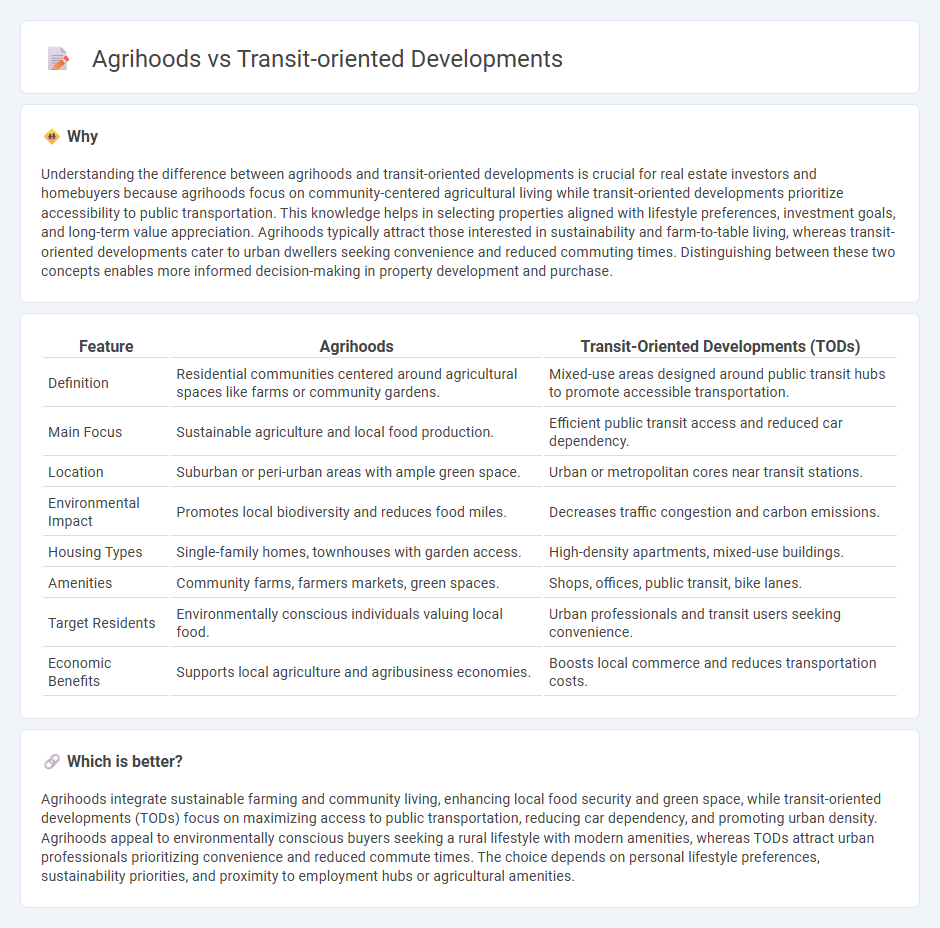
Agrihoods integrate sustainable agriculture and residential living, fostering community engagement and local food production, while transit-oriented developments prioritize high-density housing and commercial spaces near public transit systems to reduce car dependency. Both models address urban sustainability but cater to different lifestyle preferences and environmental goals. Explore the unique benefits and challenges of agrihoods and transit-oriented developments to determine the best fit for modern urban planning.
Why it is important
Understanding the difference between agrihoods and transit-oriented developments is crucial for real estate investors and homebuyers because agrihoods focus on community-centered agricultural living while transit-oriented developments prioritize accessibility to public transportation. This knowledge helps in selecting properties aligned with lifestyle preferences, investment goals, and long-term value appreciation. Agrihoods typically attract those interested in sustainability and farm-to-table living, whereas transit-oriented developments cater to urban dwellers seeking convenience and reduced commuting times. Distinguishing between these two concepts enables more informed decision-making in property development and purchase.
Comparison Table
| Feature | Agrihoods | Transit-Oriented Developments (TODs) |
|---|---|---|
| Definition | Residential communities centered around agricultural spaces like farms or community gardens. | Mixed-use areas designed around public transit hubs to promote accessible transportation. |
| Main Focus | Sustainable agriculture and local food production. | Efficient public transit access and reduced car dependency. |
| Location | Suburban or peri-urban areas with ample green space. | Urban or metropolitan cores near transit stations. |
| Environmental Impact | Promotes local biodiversity and reduces food miles. | Decreases traffic congestion and carbon emissions. |
| Housing Types | Single-family homes, townhouses with garden access. | High-density apartments, mixed-use buildings. |
| Amenities | Community farms, farmers markets, green spaces. | Shops, offices, public transit, bike lanes. |
| Target Residents | Environmentally conscious individuals valuing local food. | Urban professionals and transit users seeking convenience. |
| Economic Benefits | Supports local agriculture and agribusiness economies. | Boosts local commerce and reduces transportation costs. |
Which is better?
Agrihoods integrate sustainable farming and community living, enhancing local food security and green space, while transit-oriented developments (TODs) focus on maximizing access to public transportation, reducing car dependency, and promoting urban density. Agrihoods appeal to environmentally conscious buyers seeking a rural lifestyle with modern amenities, whereas TODs attract urban professionals prioritizing convenience and reduced commute times. The choice depends on personal lifestyle preferences, sustainability priorities, and proximity to employment hubs or agricultural amenities.
Connection
Agrihoods and transit-oriented developments both promote sustainable living by integrating residential areas with accessible transportation and green spaces. Agrihoods focus on community-centered farming and fresh food access, enhancing local ecosystems, while transit-oriented developments prioritize proximity to public transit to reduce car dependence and emissions. Combined, they create vibrant, eco-friendly neighborhoods that support healthy lifestyles and lower environmental impacts.
Key Terms
**Transit-Oriented Developments:**
Transit-oriented developments (TODs) prioritize high-density, mixed-use neighborhoods centered around public transit hubs, promoting walkability and reducing car dependency. These developments enhance urban mobility, decrease traffic congestion, and support sustainable living by integrating residential, commercial, and recreational spaces within a compact area. Explore how TODs transform urban landscapes and foster eco-friendly communities.
Mixed-use zoning
Transit-oriented developments (TODs) emphasize high-density, mixed-use zoning designed to maximize access to public transport, integrating residential, commercial, and retail spaces within walkable distances to reduce car dependency. Agrihoods, on the other hand, incorporate mixed-use zoning centered around agricultural features such as community farms and green spaces, blending residential living with sustainable food production and outdoor amenities. Explore the key differences and benefits of mixed-use zoning in TODs and agrihoods to understand their unique contributions to urban planning.
Walkability
Transit-oriented developments (TODs) prioritize walkability by integrating residential and commercial spaces within close proximity to public transit hubs, reducing dependency on cars and encouraging pedestrian movement. Agrihoods enhance walkability through walkable access to urban farms, community gardens, and green spaces, promoting healthier lifestyles and stronger community ties. Explore the unique walkability features of TODs and agrihoods to understand their impact on sustainable living.
Source and External Links
Transforming the Urban Space Through Transit-Oriented Development - Transit-oriented development (TOD) is an urban planning strategy that clusters jobs, housing, and services around public transit stations to promote compact, mixed-use, pedestrian- and bicycle-friendly communities, boosting economic productivity and city livability by reducing commuting distances and supporting public transit viability.
Transit-oriented development - Wikipedia - TOD maximizes residential, business, and leisure spaces within walking distance of transit; globally, projects like those in Bangkok aim to create walkable, mixed-use communities centered on transit, improving economic activity, reducing congestion, and enhancing residents' quality of life.
Transit-Oriented Development | FTA - In the U.S., TOD integrates dense, walkable, mixed-use development near transit to foster vibrant, connected communities, offering benefits such as neighborhood revitalization, affordable housing, increased transit ridership, congestion relief, and improved pedestrian safety, supported by significant federal funding programs.
 dowidth.com
dowidth.com